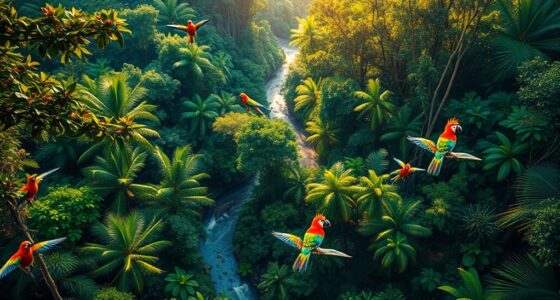Understanding whether a species is endangered or threatened can seem complex, but it’s essential for effective conservation. By grasping the differences, you can better appreciate why certain actions are urgent while others are preventative. These distinctions influence how resources are allocated and which strategies are prioritized. Exploring the criteria and organizations involved reveals the larger picture of biodiversity protection — a subject that might just change how you see conservation efforts.
Defining Endangered and Threatened Species
Understanding the difference between endangered and threatened species is essential for effective conservation efforts. An endangered species faces an extremely high risk of extinction in the wild. You might see these animals or plants with declining populations, habitat loss, or threats like poaching.
Threatened species, on the other hand, are at risk but not as imminently endangered. They’re likely to become endangered if conditions worsen. Recognizing this distinction helps you prioritize conservation actions.
Endangered species need urgent interventions, while threatened ones require monitoring and preventative measures. Both categories highlight the importance of protecting biodiversity, but knowing their differences guides resource allocation and policy decisions.
Clear definitions enable you to support targeted conservation strategies and advocate for species’ survival effectively. Contrast ratio plays a key role in how images of these species are perceived in visual media, influencing public awareness and support for conservation efforts.
Criteria Used to Classify Conservation Status
Scientists and conservationists use specific criteria to determine a species’ conservation status, ensuring assessments are consistent and evidence-based. They evaluate factors like population size, rate of decline, geographic range, and habitat quality.
For example, a species with fewer than 2,500 mature individuals and a continuing decline may be classified as endangered. Geographic range is assessed through extent of occurrence and area of occupancy; smaller ranges often indicate higher risk.
Habitat degradation or fragmentation also influence status decisions. These criteria help distinguish between species that are truly at risk versus those facing less immediate threats.
The Role of the International Union for Conservation of Nature (IUCN)
The International Union for Conservation of Nature (IUCN) plays a central role in global conservation efforts by providing authoritative assessments of species’ risk levels. You rely on the IUCN’s Red List to understand which species face the greatest threats of extinction.
The IUCN evaluates thousands of species worldwide using standardized criteria, helping you identify conservation priorities. Their assessments influence international policies, funding, and conservation actions.
By maintaining an up-to-date, comprehensive database, the IUCN ensures you have reliable information to guide decisions. Their work also raises awareness about biodiversity loss and encourages collective responsibility.
Ultimately, the IUCN acts as a global authority, shaping strategies to protect vulnerable species and preserve ecosystems for future generations.
How Governments and Organizations Assess Risks
Governments and organizations assess risks by using a combination of scientific data, field surveys, and technological tools to evaluate the vulnerability of species and ecosystems. They gather population data, habitat information, and threats like habitat loss or pollution. A new sentence with vetted products and the rest of the sentence. Remote sensing and GIS technology help monitor changes over time and identify areas at risk. Experts analyze trends to determine how quickly a species’ numbers are declining or how severely its habitat is shrinking. Risk assessments consider factors such as reproductive rates, genetic diversity, and exposure to hazards. This comprehensive approach allows authorities to prioritize conservation efforts effectively.
Why the Distinction Matters for Conservation Strategies
Understanding the specific conservation status of a species or habitat is crucial because it guides how resources and efforts are allocated. If a species is endangered, it needs immediate, intensive intervention to prevent extinction.
Conversely, if it’s threatened, proactive measures can stabilize its population before it becomes critically at risk. This distinction affects priorities, funding, and strategies, ensuring efforts target the right actions at the right time.
For example, endangered species may require habitat restoration or captive breeding programs, while threatened species benefit from habitat protection and monitoring. Recognizing these differences helps you implement effective, efficient conservation plans.
It prevents wasting resources on species that don’t need urgent help and ensures you focus on those most at risk. This targeted approach increases the chances of long-term conservation success.
Examples of Endangered and Threatened Species
Many species around the world face imminent threats to their survival, with some on the brink of extinction and others at risk of becoming endangered if conditions worsen.
For instance, the Amur leopard is critically endangered, with fewer than 100 individuals left in the wild due to habitat loss and poaching.
The vaquita, a rare porpoise, is critically endangered because of bycatch in fishing nets, with fewer than ten remaining.
On the other hand, the monarch butterfly is threatened, mainly because of habitat destruction and pesticide use.
These examples highlight how diverse threats impact different species. Recognizing these differences helps you understand the urgency of conservation efforts and the importance of protecting both critically endangered and threatened species before they reach the brink of extinction.
Additionally, understanding the conservation status of species can guide effective preservation strategies and prioritize resource allocation.
How You Can Support Conservation Efforts
You can make a meaningful difference in conservation efforts by taking simple actions in your daily life. Start by reducing your use of single-use plastics and recycling whenever possible. Support eco-friendly products and companies committed to sustainable practices. Educate yourself and others about endangered and threatened species to raise awareness.
Volunteer with local conservation groups or donate to organizations working to protect wildlife and habitats. When traveling, choose eco-conscious tour operators and avoid disturbing natural environments. Participate in community cleanups or tree-planting events to help restore ecosystems.
Advocate for stronger environmental policies and speak out against activities that harm the environment. Every small step adds up, and your efforts can directly contribute to the preservation of our planet’s precious biodiversity.
Conclusion
Understanding the difference between endangered and threatened species helps you see why targeted conservation matters. By recognizing which species need urgent action and which require ongoing monitoring, you can support efforts that protect biodiversity effectively. Your awareness can inspire responsible choices and advocacy, making a real impact. Together, we can ensure that vulnerable species receive the attention they deserve, preserving our planet’s rich variety of life for future generations.





